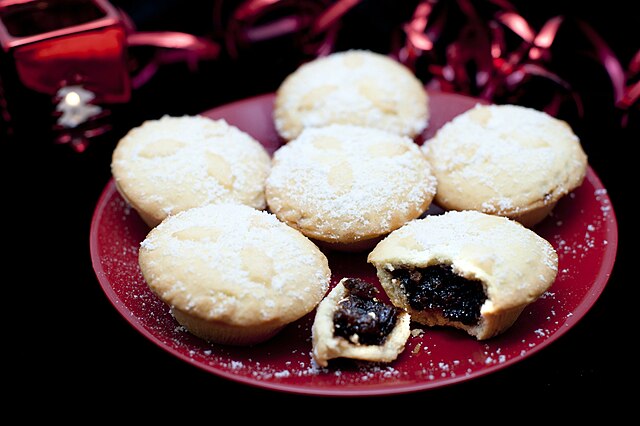
Why are mince pies called mince pies and why are puddings called puddings? Mince pies are called mince pies because they used to contain minced meat (ground beef) and puddings are called puddings because they used to be encased in some kind of skin and steamed.
Mince pies are a traditional food eaten at Christmas in the UK. They are eaten in Australia and New Zealand as well. Some people in America might eat them, but they are not very well known, or even known at all, there. A mince pie is a small pastry case, small enough to hold in the palm of the hand. It is filled with spiced, sweet, dried fruit that has been cooked in some kind of alcohol. The filling of a mince pie is called mincemeat, and this is where this question comes from. Why don’t they contain meat if the filling is called mincemeat? Well, they did contain meat in the past.
Mince pies have been eaten in England for hundreds of years, but the mincemeat that goes in them wasn’t invented in England. England has a lot of natural herbs and spices, but many of the spices in mincemeat are not native to England. Mincemeat and these spices were brought back to England by knights who fought in the crusades in the 13th century. They also brought back lemons, sugar, glass mirrors, soap, some dyes, rice, and many different spices. They went there to free the Holy Land, but they ended up bringing a lot of the culinary culture back with them. One thing they brought back was mincemeat, which was chopped up meat cooked in fruits and spices. It sounds strange to think that meat would be cooked this way, but a lot of cultures cook meat in sweet sauces, including our own. We have cranberry jam on turkey and apple sauce on roast pork, for example.
Mincemeat became popular and it was made with whatever meat was at hand. Mutton, rabbit, different types of game, and pork were probably the most popular because they were the cheapest, but beef was eaten as well. There is a record that King Henry V served a mincemeat pie at his coronation in 1413. However, the pies eaten at the time were proper pies and much larger than the small mince pies we have today. Over the years they changed shape and took on religious significance. They became associated with Christmas because the three main spices they used, nutmeg, cloves, and cinnamon, were said to represent the gifts the three wise men brought to Jesus. They were made in an oblong shape, to represent the baby Jesus’s crib, and they had a pastry Jesus on top as well. I’m not sure how religious it is to eat a pastry Jesus. By the Victorian era, they had become round and much smaller. It was only in the early 20th century that people stopped putting meat in them and they became the sweet pastries that we know today.
Why are puddings called puddings? These days, we often use the word pudding to refer to dessert, but puddings used to be savory. The word probably comes from the French “boudin”, which meant “small sausage”. Puddings were some kind of meat encased in a skin and steamed, like a large sausage. Haggis (the famous Scottish food), and black pudding are both steamed meats inside a skin. They were probably brought to England by the Romans and then slowly evolved over time to become bigger and have different fillings. By the 17th century, the savory puddings still existed, but sweet puddings had become popular. This probably coincided with the reduce in cost of imported sugar. By the 19th century, sweet puddings were more popular than savory puddings. These days, in the UK, we still use the word pudding to refer to savory steamed foods, such as steak and kidney pudding, but it is more commonly used to refer to sweet puddings and, more commonly, to refer to dessert in general. However, in America, pudding has a different meaning. In America, pudding is used to refer to what people in the UK would call custard. Americans had savory puddings in the early days, but they went out of favor in the early 19th century. Americans appear to have started calling custard “pudding” in the 1840s. This is because these puddings are made by covering them and then steaming them, in the same way that savory puddings used to be made. And this is what I learned today.
Image By christmasstockimages.com – http://christmasstockimages.com/free/food-dining/slides/mince_pie_plate.htm, CC BY 3.0, https://commons.wikimedia.org/w/index.php?curid=97503821
Sources
https://www.historic-uk.com/CultureUK/Mince-Pies
https://www.walkersshortbread.com/the-history-of-mince-pies
https://en.wikipedia.org/wiki/Mince_pie
https://www.factmonster.com/history/world/dk-history-crusades
https://en.wikipedia.org/wiki/Pudding
